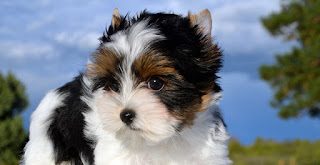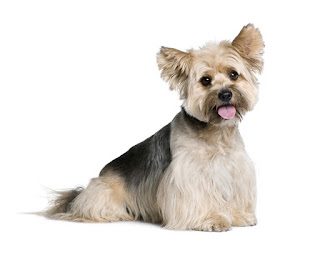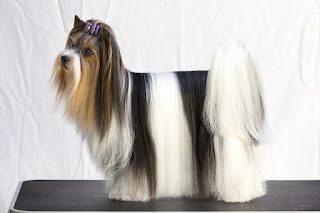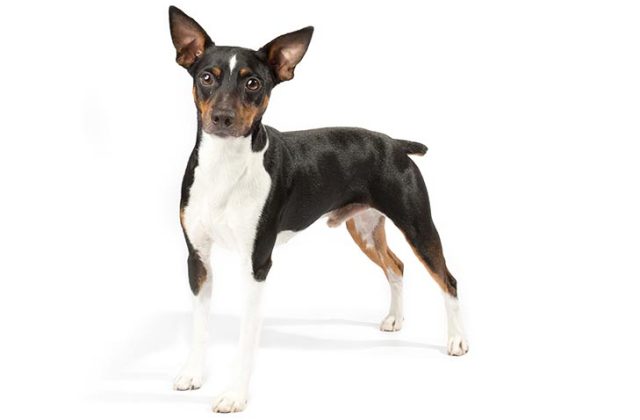Everything about your Biewer Terrier
The Biewer Terrier, also known as the Biewer Yorkshire Terrier a la Pom Pon, the Biewer Yorkie or just the Biewer, is a fairly new toy terrier breed. It has not yet been recognized by the American Kennel Club, but is recognized by the American Rare Breed Association (ARBA) and of course by their own American breed club, the Biewer Terrier Club of America (BTCA).
Overview
At first glance, the Biewer Terrier looks like a colorful tricolored Yorkie or a hybrid mix between a Maltese and Yorkie .
Biewer Terrier is a modern breed in the making right before our very eyes.
Pronounced “Bee-Vair,” the breed was first discovered and developed in Germany by a couple, Werner and Gertrude Biewer, Yorkshire terrier breeders. They mated two of their dogs together in 1984 and produced a blue, gold, and white dog named Schneeflocken von Friedheck. The explanation for this unusual “Yorkie” was a rare recessive piebald gene mutation.
From there it was introduced into the United States in 2003 and continues to gain in popularity as people learn about this incredibly sweet, happy, even-tempered terrier that is a fiercely loyal companion to all those humans he determines are his family.
As you known, in USA, most Yorkies have docked tails, but the Biewer keeps his full tail as part of the standard began in Germany. As in many European countries, the practice of docking tails and cropping ears is banned and the breed’s founders in the U.S. determined that it was in the best interest to maintain this look.
Breed standards
Other Names Used: Biewer a la Pom Pon, Biewer Yorkshire Terrier, Biewer Yorkshire, or Biewer Yorkie
Affiliation: AKC FFS (May 2014); ARBA (American Rare Breed Association)
Group: Toy Dog, Companion Dog
Size: Height: 8 12 inches, Weight: 4-7 pounds
Coat Type: Long and Silky; No undercoat
Colors: Black/Blue with Tan/Gold and White
Hypoallergenic: Yes
Country of Origin: Hunsruck, Germany
Activity Level: Moderate
Life Expectancy: 12 to 15 years
Good with Children: Yes (Older children)
Good with other pets: Yes
Comparable Breeds: Yorkshire Terrier, Silky Terrier
History
The Biewer Terrier came to be its own breed as a result of a Yorkshire Terrier puppy born in Germany in January of 1984 that had an extreme amount of white patterning throughout his coat. This unusual puppy, named Scheefloeckchen von Friedheck, caused his breeders, Werner and Gertrud Biewer, to wonder whether their Yorkies carried a recessive piebald gene, which apparently they did. Over the next several years, the Biewers bred for the piebald gene and produced blue, white and gold Yorkshire Terriers that bred true to their color. Mr. Biewer showed two of his unique dogs as “black and white Yorkies” in 1988, and the breed took off from there. Biewer Terriers were first officially recognized by the Allgemeiner Club der Hundefreunde Deutschland e. V., one of Germany’s dog clubs. The Biewers signed off on the Biewer breed standard in the late 1980s. Mr. Biewer died in 1997; thereafter, his widow stopped breeding dogs. The Biewer Terrier Club of America was established in 2007. Today, this is still considered to be a rare breed.
Temperament
Having a friendly and affectionate nature, the Biewer Terrier is quite comfortable enough to mingle.
They also possess a highly loyal and dedicated nature, loving to spend quality time with their masters and other family members.
The Biewer Terriers are at times childlike and whimsical in their behavior, loving to do a lot of amusing things like carrying a toy in his mouth.
In spite of their pleasing nature, they may sometimes be strong willed and yappy just like the Yorkshire Terrier, trying to have the upper hand over their masters.
They are wary and suspicious on seeing an unfamiliar face at the beginning, even going to the extent of warning the owner about the same. However, they gradually get along well with the stranger once they realize that he is not a threat to their household. Inappropriate socialization might make these small breeds little aggressive towards strangers.
These dogs are said to have a greater personality than their size, thus making them a little difficult while dealing with other dogs particularly the bigger ones or even cats.
Besides being perfect companions to all, especially the elderly group, this breed is ideal for homes with older children who can deal with them in a responsible way rather than the little ones who can be restless enough with them.
Health
Given the fact that Biewer Terrier was bred from the Yorkshire Terrier, they share the same sort of health problems. Some of the most common genetic disorders seen in this breed include patellar luxation, Legg-Calve-Perthes syndrome, portosystemic shunt, bladder stones, and tracheal collapse. Other conditions these dogs may develop include distichiasis and hypoglycemia.
Care
As with any other breed, Biewers need to be groomed on a regular basis to make sure their coats and skin are kept in tip-top condition. They also need to be given regular daily exercise to ensure they remain fit and healthy. On top of this, they need to be fed good quality food that meets all their nutritional needs throughout their lives.
Living Conditions
The Biewer Terrier can live in an apartment if it gets enough exercise. They are fairly active indoors and will do okay without a yard.
Training
The Biewer Terrier is a smart little dog that generally responds well to a firm and consistent hand in training. Like many toy breeds, the Biewer Terrier is prone to developing small dog syndrome if not properly trained. Biewer Terriers can be somewhat difficult to housebreak and they can be a little overprotective at times. As long as you start training early and remain consistent, you shouldn’t have any trouble training your Biewer Terrier.
Exercise Requirements
Toy breeds don’t need a whole lot of room to run, but even apartment Biewers should be walked regularly, to avoid becoming overweight. In a fenced-in yard they will run and play with children, but should never be left off leash, as they will chase after just about anything that catches their eye – even cars.
Though Biewers can get along swimingly with larger dogs, they should be socialized as early as possible to learn to accept new people and situations. They can be wary of strangers and once a fearless little Biewer postures, it’s difficult to talk them down.
The Biewer Terrier is a naturally active breed that requires regular daily exercise to work off his excess energy. If a daily walk is not possible, some active playtime will usually fulfill this dog’s needs for exercise. Without enough exercise of some form, however, this breed is likely to develop behavioral problems such as digging and chewing.
Grooming Needs
The long, silky coat may appear to be intimidating to groom, but it is easy to care for. Daily brushing is required to keep the coat free from dirt and tangles. Biewers should not be brushed when they are completely dry, as it will damage the hair. A spray bottle with water or a mix of water and dog conditioner will do the trick. Weekly baths are necessary to keep the coat in good condition, and some keep bath wipes on hand to clean the underside of the dog on a daily basis. While some owners elect to trim the dog all over, the only trimming that is absolutely necessary is around the ears (so they don’t get weighed down), the rectum (for hygienic reasons) and under the pads of the feet.
Regular tooth brushing and ear cleaning sessions should also be part of the grooming routine, as these practices promote good health and keep harmful bacteria from growing in the mouth or ear.
Children and Other Pets
Biewer Terriers are not the best choice for people with toddlers and young children because these little dogs can be a little snappy if they feel threatened in any way. They are a good choice in households where the children are older and therefore know how to behave around dogs and more especially when they are interacting with such small dogs.
They are known to be a little aggressive around other animals and this includes cats which is why they need to be well socialised from a young age although it would be a mistake to trust a Biewer around other smaller pets because of their “terrier” traits. They can be aggressive towards other dogs too, bearing in mind that Biewers have no idea of how small they really are. As such care has to be taken when out on a walk in a public place where other dogs are commonly being walked too.
Is the Biewer the Right Breed for you?
High Maintenance: Grooming should be performed often to keep the dog’s coat in good shape. Professional trimming or stripping needed.
Minimal Shedding: Recommended for owners who do not want to deal with hair in their cars and homes.
Easy Training: The Biewer is known to listen to commands and obey its owner. Expect fewer repetitions when training this breed.
Fairly Active: It will need regular exercise to maintain its fitness. Trips to the dog park are a great idea.
Good with Kids: This is a suitable breed for kids and is known to be playful, energetic, and affectionate around them.








